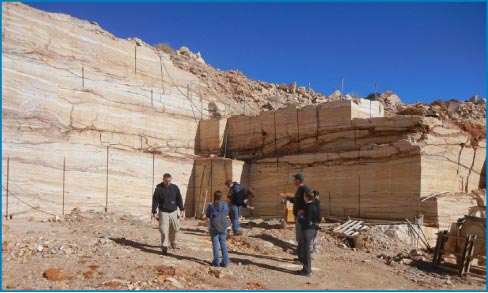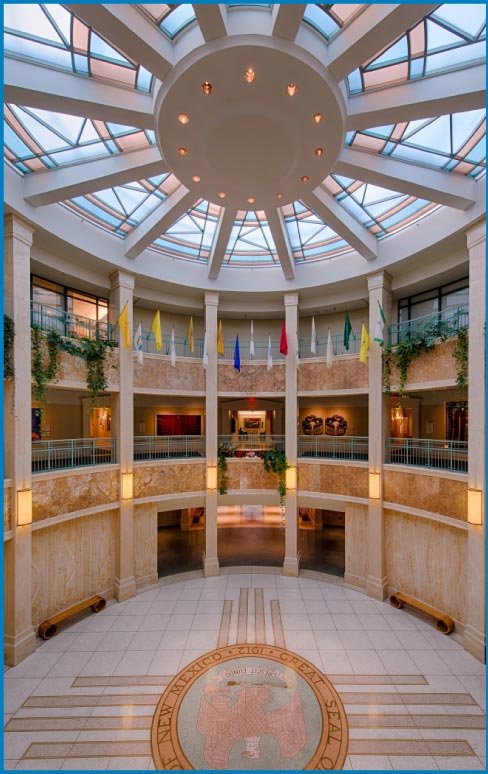New Mexico Travertine
 |
|
Above: Jim Lardner conducts a group tour of the New Mexico Travertine quarry of West Belen, New Mexico. |
 |
|
Above: New Mexico State Capitol building rotunda features panels and wall cladding of NM Travertine. |
Back in the mid-1950s, there was a geologist working out of Moab, Utah, who had made a lot of money in the uranium business and came to New Mexico to look into a travertine deposit that he had seen in his research.
He was in the process of building a new home on the top of a hill overlooking Moab and wanted to see about using the travertine for his new home. That house is still there today, and was turned into a restaurant a few years ago.
When he tracked down the current owner of the New Mexico deposit, he found that unless he got into the quarrying and cutting business, there was no way he’d be able to get the materials he needed for his home, so he cut a deal with the rancher and started a company called “Ultra Marble.”
He did a mapping of the travertine deposits that are located about 20 miles west of Belen and proceeded to sell stock in the new business and shortly thereafter, started quarrying the travertine.
They set up a very small processing facility in Albuquerque, but the majority of the processing for the commercial jobs they sold was done Carthage, Missouri.
The New Mexico State Capitol Building was built in 1958 using this travertine. For that project, they sent all of the blocks to Carthage, Missouri to the Carthage Marble Company, who actually processed all the stone, and then shipped it back to New Mexico.
Sometime between 1975 and 1976, Ultra Marble fell on hard times.
The IRS came in and shut them down, and Vince Lardner was able to negotiate a deal to buy the travertine rights on about 1,300 acres of land.
This purchase of the travertine quarries launched us into the dimensional stone business.
We built a small building in Albuquerque and put in a little processing plant that consisted of a wire saw, a bridge saw and a radial arm polisher.
We started bringing blocks up and wire sawing slab material for making vanity tops, hearths and other assorted items.
In 1984, New Mexico Travertine was started and a new plant was built in Belen, New Mexico, with a gang saw, polishing line and a production bridge saw.
The first major project done at the new plant was almost 60,000 square feet of travertine for cladding at the West Lake transit station in Seattle, Washington.
New Mexico Travertine is still in operation today, operating three quarries in New Mexico and is known for first class processing of both travertine and various domestic limestones for both residential and commercial applications throughout the entire country.
Read The Rebirth of a Stone Industry Legend in the Slippery RockGazette.net archives, May issue, 2017, for more information about the Carthage Marble Company.